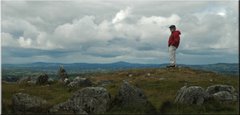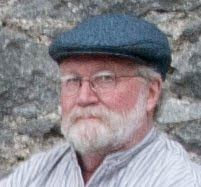The "just taken yesterday" appearance of those slides is due primarily to two causes. First, my Dad's meticulous attention to detail, cataloging, and archiving. His slide collection is housed in a number of hand-made boxes, designed to keep the slides immobile, in order, and away from light and other contamination.
The other cause is this:
... no, not the bear, but the gizmo the Alcatraz bear is sitting on: our slide scanner. The scanner and its associated software can do miraculous things for old slides. Through a combination of hardware, software, and a database of emulsions' aging characteristics, Dad's thousands of old slides are coming back to life. Here are two examples from the last post, the ones I called "Beach frolics" and "Mom and me in a roadside diner." Both photos were taken in April, 1961.
 "Beach frolics" after the scanner removed most of the physical flaws in the slide: dust, scratches, etc.
"Beach frolics" after the scanner removed most of the physical flaws in the slide: dust, scratches, etc.Since different emulsions' dyes "dark fade" in different ways, the emulsion type must be specified by the scanner operator. Looks like it worked pretty well for this Agfachrome shot.
This slide had virtually no emulsion damage at all -- no scratches, fingerprints, etc. The reason for its pristine condition is pretty easy to figure out: it's a bad snapshot, one that's exposed well for the sunny parking lot outside the windows, but badly underexposed for the subject itself.
This shadow detail restoration is different from simply brightening the image; note that the parking lot is still properly exposed, but the diner interior has been brightened and contrast-adjusted to bring it to life, too. I've elevated the shadow detail here and tweaked the color balance for dramatic effect; this is the more realistic way it appeared in the previous post:

Other examples of slide restoration in this years-long project can be seen here, and there are many, many more options, bells, and whistles in the hardware/software than I will ever learn how to use. But that's okay; the aim for me is to preserve Dad's pictures the way he wanted them to look, and I think we're doing that pretty well.
Side note: the computing resources this project takes up has given me an abiding appreciation for the staggering magnitude of a little 35mm slide's analog data storage. I store each slide's scan in a "raw" format, from which any number of graphics programs can operate on the image. To preserve as much information as possible, I have all of the quality preservation options maxed out, which yields a typical file size for a single slide of about 120 megabytes, and, even at that, I'd bet that I'm not within two orders of magnitude of capturing all of the information on each slide.
Look back at the second slide, the one showing the scanner. Next to the scanner, behind the dancing bears, is a DVD burner. Beside that, with the blue light, is a Seagate 500 gig external hard drive. Those are just a fraction of the data storage and backup that this project uses, but I worry about them. I wonder if the media they produce will even be readable as long from now as now is from when the slides were taken. Oh, well, maybe that will give Grace a hobby in 2056 or so.
=========================================









3 comments:
Wow! I am really impressed! Thanks for sharing the process - it was really interesting to see the various stages of restoration. It's wonderful that these images can be transformed into a much truer representation of what the human eye would've seen if we'd been standing there decades ago.
ronnie
Ronnie, all the various options that the restoration hardware/software affords drags me down into a wondering without answer: what do things really look like? I don't think there's any better answer to that than there would be to "what do things really sound like?" so we fall back to our preconceptions for a base. Fifty years from now, that base may seem stilted, or it may not.
Still, the snapshots look better to me after the massaging, which is why I'm spending at least five minutes per slide digitizing them.
Adam, I sure hope you'll be alive in 2056, and as sharp, inquisitive, wise, and active as Ronnie-without-a-cat is now in her mid-eighties. But not many of us are constituted that way. Surprise me.
And the bears... they're not mine, d00d, they're part of Diane's decorating, ah, scheme. Yeah, "scheme," that's it.
Your friend John Mitchell once described my decorating tastes as "minimalist." Diane took care of that, eh? My tastes are still the same as they were three decades ago, but they're covered up now by layers of... stuff.
Post a Comment